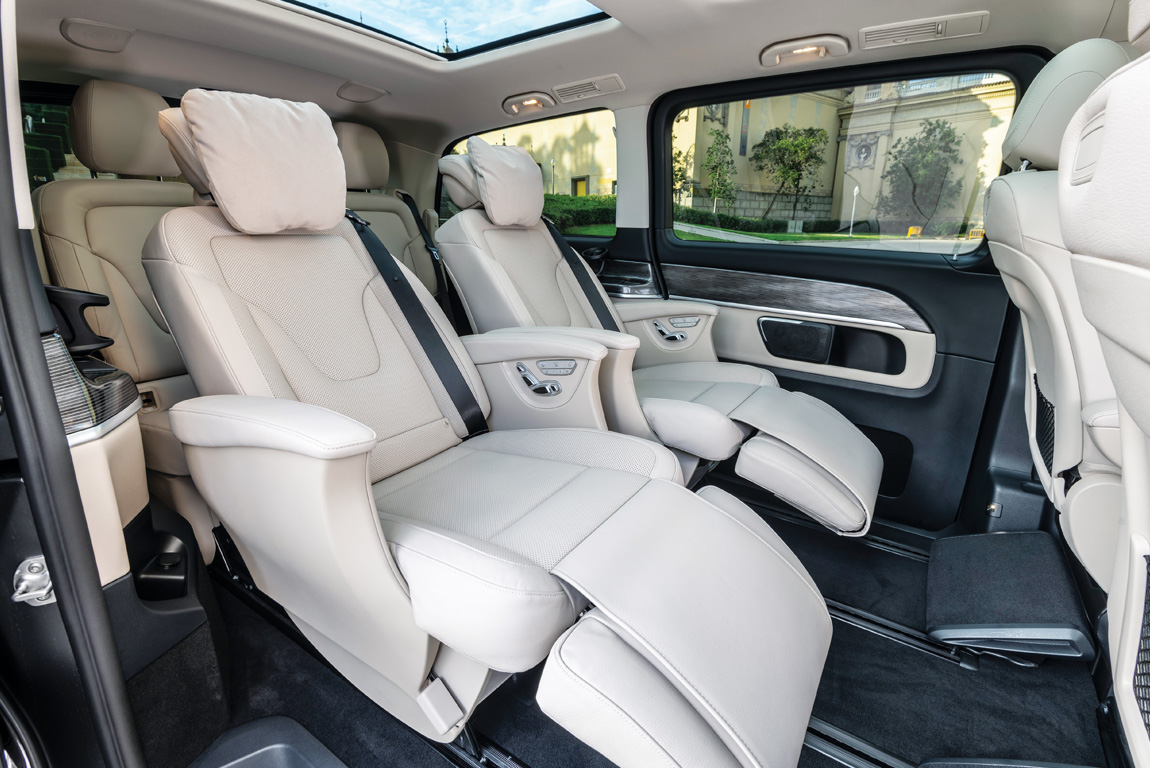V stands for VERY nice!

The facelifted V-Class is about to blast into South Africa. CHARLEEN CLARKE shot off to Sitges to drive it
2014 was one hell of a year. Ebola broke out in West Africa, a Malaysian Airlines flight from Kuala Lumpur destined for Beijing vanished, the Islamic State of Iraq and Syria (ISIS) emerged and Robin Williams committed suicide at the age 63.
However, not everything about 2014 was bad! It was the year that we first saw the Mercedes-Benz V-Class! A personal highlight for yours truly in 2014 was a visit to the Vitoria plant in Spain’s Basque country, which is where the V-Class is built.
The plant – which happens to be the oldest van plant in Europe – is situated on a site area of almost 600 000 m2. The production area measures some 257 000 m2 and is home to 3 500 personnel, who produce about 470 vans per day over two shifts.
The Vitoria plant is located just under one hour’s drive from the city of Bilbao. I was privileged to be taken on a really great tour of the facility by a cute and very enthusiastic little Spanish chap who looked a lot like Fernando Alonso.

However, I digress. Five years later, I found myself heading to Spain yet again. I was not there to hang out with Alonso lookalikes, but rather to hang out with the facelifted V-Class. Mercedes-Benz chose to host the world launch in a drop-dead pretty place called Sitges, which is just down the road from Barcelona.
Sitges is famous for many things, not least of which being its warm “micro-climate” that makes it possible to enjoy outdoor activities almost every day of the year. I was about to enjoy an outdoor activity of the finest sort: drive the V-Class.
On most press trips, we’re partnered with another journalist. This can be cool when you hook up with someone awesome (it’s not so cool when you’re partnered with some who cannot drive – which has happened to me on more than one occasion). This time around though, I was in a group with Russians and Eastern European journalists. None of them spoke a single word of English, and so Mercedes-Benz decided that I was to travel solo. What a treat!
I say this not because I’m antisocial. (Well, actually, maybe sometimes I am.) I say this because I could be self-indulgent. It was a case of just me, the V-Class and the open road. What bliss.
Before hitting the road, though, I did my customary walk-around the new vehicle. One of the features of the facelifted V-Class is a slightly redesigned exterior. It has a new bumper design with prominent cooling air inlets and a new diamond structure in the radiator grille. The Mercedes star is positioned centrally in the radiator grille and it is framed by two silver slats. It looks very passenger car-like…
The latest V-Class can be clothed in various new paint colours. I particularly like the hyacinth red metallic, which is very popular among Mercedes-Benz passenger car drivers (and understandably so; it’s cool).
The next step was to hop inside the V-Class and explore the interior, which is a really cool place to be. It’s incredibly plush and luxurious. There are some new features that have been adopted from the passenger-car range – such as the new air vents, which have a so-called “turbine look” and hail from the A-Class.
There’s new leather upholstery, “borrowed” from the E-Class and G-Class – and it’s quite magnificent. The seats are supportive and extremely comfortable. Incidentally, in South Africa, the V-Class comes standard with seven seats; an eighth seat is optional.
Next up was the real fun part: the actual drive. The Seriously Big News on an international front is the launch of the OM654 engine-powered V 300 d, which delivers 176 kW of power and 500 Nm of torque. In the acceleration phase, the V 300 d can briefly deliver an additional 30 Nm of torque. The V 300 d accelerates from 0 to 100 km/h in up to 7,9 seconds, it can reach a top speed of 220 km/h and it’s such a sweet motor.
I loved the time I spent behind the wheel of this model, but (and here’s the bad news) it’s not coming to South Africa. This is because South Africa does not accept the Worldwide Harmonised Light Vehicle Test Procedure (WLTP) certification standard of the OM654 engine. Go figure… (Just in case you’re wondering, the WLTP laboratory test is used to measure fuel consumption, CO₂ emissions and pollutant emissions from passenger cars in Europe.)
Bearing this in mind, facelifted V-Class derivatives destined for our shores will be equipped with the same 2,1-litre engine that was fitted to pre-facelift models. It will be equipped to the V 200, V 220 and V 250 d (which will be available in both Standard and more upmarket Avantgarde spec’d derivatives).
The transmission remains the 7G-Tronic Plus, a seven-speed auto. This four-cylinder engine displaces between 100 and 140 kW of power and 330 to 440 Nm of torque. So, while it doesn’t quite have the grunt of the OM654, it does a perfectly adequate job.
Whereas there is no big news (for South Africans, anyway) on the engine front, there are a number of other developments that are of interest. The most important is the addition of two great safety features (which will probably be fairly pricey add-ons here in South Africa).

The first is Active Brake Assist, which is new to the V-Class but not to many other Mercedes-Benz models. It’s a really good safety feature and I put it to the test in Sitges (unintentionally, it must be said). I was speeding down the highway in my V-Class, humming a merry tune, when a crazy local cut in front of me and then slammed on brakes for some or other unknown reason (it must be said that some of the Spanish drivers make our minibus taxi drivers look good).
To be frank, I was chilled… because I was driving in a mountainous area outside Sitges and I was admiring a castle that was about a million years old at the time. Luckily for me, the Active Brake Assist realised that I was about to drive right over the local (which would not have been good for international relations) and it slowed my V-Class down. Fast. It’s a great feature.
The other is called Highbeam Assist Plus. I never tested it because I only frolicked through the roads of Spain during the day. However, it’s also a super feature, because, in the event of vehicles in front or oncoming traffic, the LEDs of the main-beam module are partially deactivated, creating a U-shaped cut-out in the cone of light. The remaining areas of the roadway continue to be illuminated with the main-beam headlamps (partial main beam). It’s really smart. Fellow road users will love it.
So, in conclusion, what do I think of the latest V-Class? Were I to pick a multi-purpose vehicle for a really long road trip, the V-Class would certainly be right up there … it offers a decidedly first-class ride for the driver and passengers alike. It would make a great shuttle for DPPs (decidedly posh people); I can just imagine my esteemed neighbour, one Julius Malema, and his bodyguards swanning around town in a V-Class. Over 200 000 V-Class units have been sold since its launch in 2014 … and you can expect to see that figure ticking over…
Published by
Charleen Clarke
focusmagsa




